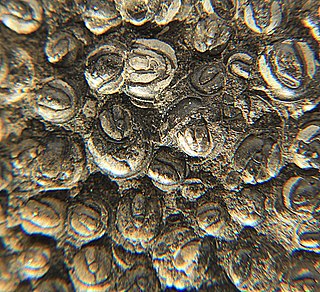 W
WAgnostus, is a genus of agnostid trilobite belonging to the Family Agnostidae, that lived during the late Middle Cambrian – early Upper Cambrian. It is the type genus of the family Agnostidae and is subdivided into two subgenera, Agnostus and Homagnostus.
 W
WAmpyx is an Ordovician-Silurian genus of Asaphid trilobites of the family Raphiophoridae. Species of Ampyx are characterized by three extended spines on the head-shield, one spine derived from each free cheek, and one spine emanating from the glabellum. Species include Ampyx linleyensis.
 W
WAtrypa is a genus of brachiopod with shells round to short egg-shaped, covered with many fine radial ridges, that split further out and growthlines perpendicular to the costae and 2-3 times wider spaced. The pedunculate valve is a little convex, but tends to level out or even become slightly concave toward the anterior margin. The brachial valve is highly convex. There is no interarea in either valve. Atrypa was a cosmopolitan and occurred from the late Lower Silurian (Telychian) to the early Upper Devonian (Frasnian). Other sources expand the range from the Late Ordovician to Carboniferous, approximately from 449 to 336 Ma. A proposed new species, A. harrisi, was found in the trilobite-rich Floresta Formation in Boyacá, Colombia.
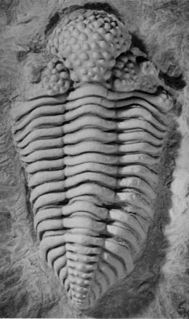 W
WBalizoma is a genus of trilobites from the family Encrinuridae established by David J. Holloway in 1980. It has only been found in rocks of Silurian age. Its type species, B. variolaris, is currently the only named species of the genus, and is found in England. The neotype of B. variolaris was collected from the Much Wenlock Limestone Formation at Dudley, West Midlands. That specimen was first illustrated in Sir Roderick Impey Murchison's classic book, The Silurian System. B. variolaris was the original "strawberry-headed" trilobite of Dudley, so-named because of its nodular glabellar tubercles, and well known to early trilobite collectors. Additional species were originally assigned to Balizoma, but were subsequently placed in other encrinurine genera.
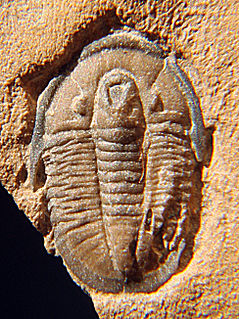 W
WCedaria is a small, rather flat trilobite with an oval outline, a headshield and tailshield of approximately the same size, 7 articulating segments in the middle part of the body and spines at the back edges of the headshield that reach halflength of the body. Cedaria lived during the early part of the Upper Cambrian (Dresbachian), and is especially abundant in the Weeks Formation.
 W
WChonetes is an extinct genus of brachiopods. It ranged from the Late Ordovician to the Middle Jurassic.
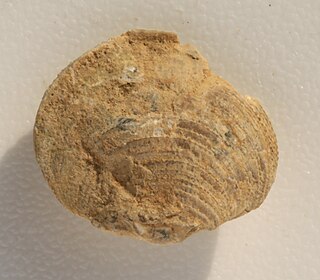 W
WCleiothyridina is an extinct genus of brachiopods.
 W
WClimacograptus was a Cambrian genus of graptolite.
 W
WCnemidopyge is a genus of trilobites that lived during the Ordovician. Like all Raphiophorids it is blind, with a cephalon that is subtriangular to subsemicircular, carrying genal spines and a forward directed rapier-like spine on the central raised area, with the front of the glabella inflated and the natural fracture lines of the cephalon coinciding with its margin. It may be easily distinguished from other raphiophorids by the rectangular thorax with 6 segments, where other genera have a different number of segments and segments change in width over the length of the thorax. Uniquely in this genus, the inner pleural region of the frontal segment is enlarged. Also the axis and pleural fields of the pygidium are strongly segmented.
 W
WComposita is an extinct brachiopod genus that lived from the Late Devonian to the Late Permian. Composita had a cosmopolitan global distribution, having lived on every continent except Antarctica. Composita had a smooth shell with a more or less distinct fold and sulcus and a round opening for the pedicle on the pedicle valve. Composita is included in the family Athyrididae and placed in the subfamily Spirigerellinae.
 W
WCrania is an extinct genus of brachiopods that lived during the Upper Cretaceous.
 W
WDidymograptus is an extinct genus of graptolites with four rows of cups. They lived during the Middle Ordovician, to Late Ordovician.
 W
WDiplograptus was a Cambrian genus of graptolites.
 W
WEthmophyllum is an extinct genus of sea sponge known from the Cambrian period.
 W
WFavosites is an extinct genus of tabulate coral characterized by polygonal closely packed corallites. The walls between corallites are pierced by pores known as mural pores which allowed transfer of nutrients between polyps. Favosites, like many corals, thrived in warm sunlit seas, feeding by filtering microscopic plankton with their stinging tentacles and often forming part of reef complexes. The genus had a worldwide distribution from the Late Ordovician to Late Permian.
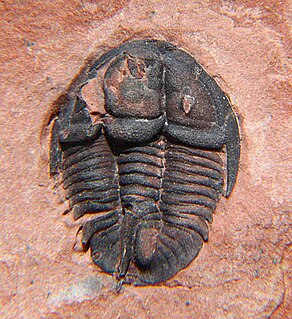 W
WGenevievella is a genus of trilobites with a short inverted egg-shaped outline, a wide headshield, small eyes, and long genal spines. The backrim of the headshield is inflated and overhangs the first of the 9 thorax segments. The 8th thorax segment from the front bears a backward directed spine that reaches beyond the back end of the exoskeleton. It has an almost oval tailshield with 5 pairs of pleural furrows. It lived during the Upper Cambrian in what are today Canada and the United States.
 W
WGlobampyx is an extinct genus raphiophorid trilobites. It lived during the later part of the Arenig stage of the Ordovician Period, approximately 478 to 471 million years ago. Species of the genus are known from Canada, Norway (Svalbard) and Sweden.
 W
WHexagonaria is a genus of colonial rugose coral. Fossils are found in rock formations dating to the Devonian period, about 350 million years ago. Specimens of Hexagonaria can be found in most of the rock formations of the Traverse Group in Michigan. Fossils of this genus form Petoskey stones, the state stone of Michigan.They can be seen and found in most Midwestern states.
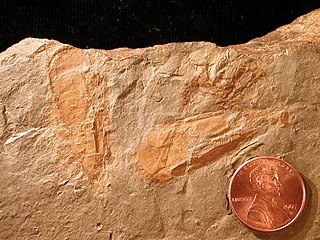 W
WHyoliths are animals with small conical shells, known as fossils from the Palaeozoic Era. They are lophophorates, a group which includes the brachiopods.
 W
WIllaenus is a genus of trilobites from Russia and Morocco, from the middle Ordovician.
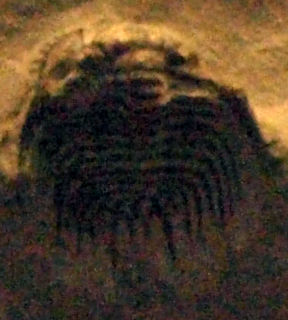 W
WLeonaspis is a widespread genus of odontopleurid trilobite that lived from the Late Ordovician to the late Middle Devonian. Fossils of various species have been found on all continents except Antarctica.
 W
WLeptaena is an extinct genus of mid-sized brachiopod that existes from the Dariwilian epoch to the Emsian epoch, though some specimens have been found in strata as late in age as the Tournasian epoch. Like some other Strophomenids, Lepteana were epifaunal, meaning they lived on top of the seafloor, not buried within it, and were suspension feeders.
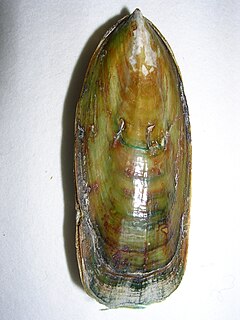 W
WLingula is a genus of brachiopods within the class Lingulata. Lingula or forms very close in appearance have existed possibly since the Cambrian. Like its relatives, it has two unadorned organo-phosphatic valves and a long fleshy stalk. Lingula lives in burrows in barren sandy coastal seafloor and feeds by filtering detritus from the water. It can be detected by a short row of three openings through which it takes in water (sides) and expels it again (middle).
 W
WLonchodomas is a genus of trilobites, that lived during the Ordovician. It was eyeless, like all raphiophorids, and had a long straight sword-like frontal spine, that gradually transforms into the relatively long glabella. Both the glabellar spine and the backward directed genal spines are subquadrate in section. Lonchodomas has five thorax segments and the pleural area of the pygidium has two narrow furrows. Lonchodomas occurred in what are today Argentina, Canada (Newfoundland), Estonia, Latvia, Norway, Sweden, the Russian Federation and the United States.
 W
WMeristella is an extinct genus of brachiopods found from the Late Silurian to the Late Devonian. They are characterized by a smooth oval shell and a prominent incurved beak on the pedicle valve. Meristella is placed in the family Meristellidae of the articulate brachiopod order Athyridida.
 W
WMetalegoceras is an extinct genus of marine cephalopods belonging to the family Schistoceratidae.
 W
WMonograptus is a genus of graptolites in the Order Graptoloidea. This particular genus is the last stage of the graptoloid evolution before its extinction in the early Devonian. A characteristic of the genus includes one uniserial stipes with very elaborate thecae. This particular genus contains large number of graptolite species and may not be monophyletic.
 W
WNaticopsis is an extinct genus of small sea snails belonging to the family Neritopsidae.
 W
WNeospirifer is an extinct genus of articulate brachiopod fossils belonging to the family Trigonotretidae.
 W
WNucula is a genus of very small saltwater clams. They are part of the family Nuculidae.
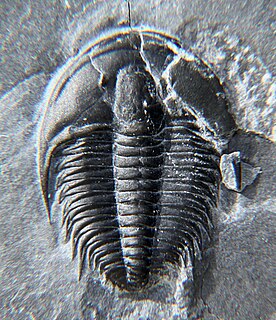 W
WOrygmaspis is a genus of asaphid trilobite with an inverted egg-shaped outline, a wide headshield, small eyes, long genal spines, 12 spined thorax segments and a small, short tailshield, with four pairs of spines. It lived during the Upper Cambrian in what are today Canada and the United States.
 W
WPentremites is an extinct genus of blastoid echinoderm belonging to the family Pentremitidae.
 W
WPhalagnostus is a genus of small trilobites, in the order Agnostida. It lived during the Middle Cambrian, in what are now Canada, China, the Czech Republic, Denmark, England, France, the Russian Federation, Wales, Sweden, and possibly the United States (Vermont). The headshield is almost entirely effaced and wider than the tailshield. The pygidium is also very effaced, but the ovate pygidial axis is well defined and a border furrow is also present.
 W
WPlaniscutellum is a genus of trilobites in the order Corynexochida family Styginidae. These trilobites were nektobenthic detritivore. They lived in the Silurian period in the upper Ludlow epoch, from 422.9 ± 1.5 to 418.7 ± 2.8 million years ago.
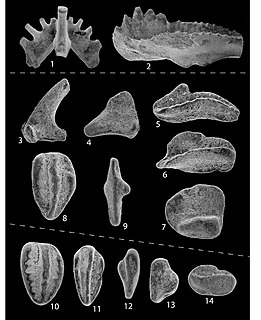 W
WPolygnathus is an extinct genus of conodonts.
 W
WSerrodiscus Richter and Richter 1941. is a genus of Eodiscinid trilobites belonging to the family Weymouthiidae Kobayashi T. (1943), Order Agnostida. It lived during the late Lower Cambrian, with remains found in Canada, China (Gansu), The United Kingdom (England), Germany (Silesia), Poland, the Russian Federation, and the United States. It is named for the spines on the ventral side of the pygidium, which give it a serrated impression.
 W
WSpirifer is a genus of marine brachiopods belonging to the order Spiriferida and family Spiriferidae. Species belonging to the genus lived from the Middle Ordovician (Sandbian) through to the Middle Triassic (Carnian) with a global distribution. They were stationary epifaunal suspension feeders.
 W
WSyringopora is an extinct genus of phaceloid tabulate coral. It has been found in rocks ranging in age from the Ordovician to the Permian, although it was most widespread during the Silurian, Devonian, and Carboniferous periods. Among other places, it has been found in the Columbus Limestone in Ohio, and in the Spring Branch Member of the Lecompton Limestone in Kansas.
 W
WTentaculites is an extinct genus of conical fossils of uncertain affinity, class Tentaculita, although it is not the only member of the class. It is known from Lower Ordovician to Upper Devonian deposits both as calcitic shells with a brachiopod-like microstructure and carbonaceous 'linings'. The "tentaculites" are also referred to as the styliolinids.
 W
WTerataspis is a comparatively huge, 60 centimetre long lichid trilobite genus from the Early Devonian, about 397 million years ago. It lived in a shallow sea in what is now New York State and Ontario. No whole specimens have been found, only disarticulated fragments of its exoskeleton, but enough fragments have been found to allow researchers to form reconstructions of the whole animal. The genus only contains one species, T. grandis.
 W
WTricrepicephalus is an extinct genus of ptychopariid trilobites of the family Tricrepicephalidae with species of average size. Its species lived from 501 to 490 million years ago during the Dresbachian faunal stage of the late Cambrian Period. Fossils of Tricrepicephalus are widespread in Late Cambrian deposits in North America, but is also known from one location in South-America. Tricrepicephalus has an inverted egg-shaped exoskeleton, with three characteristic pits in the fold that parallels the margin of the headshield just in front of the central raised area. The articulating middle part of the body has 12 segments and the tailshield carries two long, tubular, curved pygidial spines that are reminiscent of earwig's pincers that rise backwards from the plain of the body at approximately 30°.
 W
WTrinodus is a very small to small blind trilobite, a well known group of extinct marine arthropods, which lived during the Ordovician, in what are now the Yukon Territories, Virginia, Italy, Czech Republic, Poland, Denmark, Sweden, Svalbard, Ireland, Scotland, Wales, Iran, Kazakhstan and China. It is one of the last of the Agnostida order to survive.
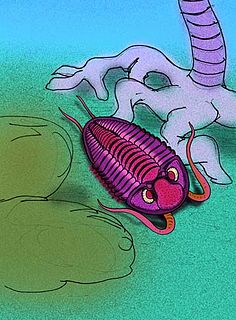 W
WTriroetus is a genus of proetid trilobite found in Upper Carboniferous-aged marine strata in Russia, and Lower Permian-aged strata of Thailand, Malaysia, Spitzbergen, Yukon Territory, and Middle Permian-aged marine strata of Oman and Texas.